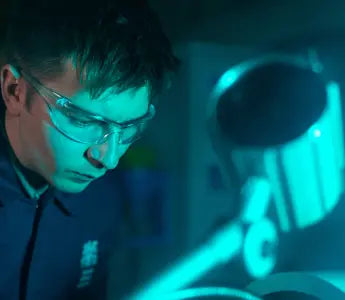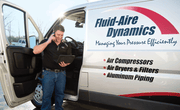Aftercoolers are among the most effective systems for heat exchange available, although finding the right type of aftercooler for your air compressor can be challenging. There are many variables to consider, including cooling efficacy, operation costs and the amount of space available in your workspace. One type of aftercooler might even be more appropriate than the other, depending on your industry.
If you are having a hard time finding the right aftercooler for you, we're here to help. This guide outlines the difference between air and water aftercoolers and the advantages and disadvantages of each.
What Is an Aftercooler?
The majority of the energy used by an air compressor is converted to heat, and as air temperature increases, the capacity for the air to store water vapor also increases. Manufacturers commonly use aftercoolers to combat both issues. Aftercoolers are heat exchanger units that remove heat and water vapor from compressed air so pneumatic equipment can use it safely.
Aftercoolers are especially useful in distribution or process manufacturing systems where excess heat or water can cause significant damage. For example, an automobile manufacturer would use an aftercooler to prevent its air-powered tools from rusting or water vapor from getting into its paint sprayers.
Air Aftercoolers
Air-cooled aftercoolers use blown air and a series of coils to reduce compressed air temperature and remove moisture. The compressed air moves through the coils of the aftercooler, and a motor-driven fan forces air over the coils to displace the heat. As the air cools, water vapor condenses and collects at the drain valve.
A belt guard air aftercooler is a special type of aftercooler that mounts directly to the compressor's belt guard. Rather than using its own fan, it uses air blown from the compressor's belt system to cool the compressed air. This is especially useful if space is a concern. Without a large fan of its own, the belt guard unit is small and thin, hardly taking up any extra room near the belt guard.
An advantage of air aftercoolers is the amount of cooling that they can provide. While water aftercoolers typically cool compressed air to 10 F - 15 F, air aftercoolers can cool to 15 F - 20 F depending on the size and materials used.
Additionally, air aftercoolers generally require less maintenance than water aftercoolers. Problems can sometimes arise in water coolers from thermal or chemical pollution of the cooling fluid. Pollution is not an issue for air coolers, and air quality has minimal effect on their efficacy.
However, if noise is a concern, know that air aftercoolers tend to be louder than water-cooled units, especially larger units with industrial fans. And while there are low-noise units available, they tend to sacrifice energy efficiency for noise reduction.
Another area of consideration is cold weather protection. Because the water vapor condenses into a high pour point liquid, it could freeze before you drain the valve. To avoid issues, consider an air aftercooler with special weather protection features if the unit is located in a cold area.
Water Aftercoolers
Water-cooled aftercoolers, on the other hand, use water to cool the compressed air. The shell and tube heat exchanger/aftercooler is the most common. In this system, hot air flows through the aftercooler's tubes, and cool water flows around the tubes in the opposite direction. As the compressed air cools, the water vapor liquefies, and the moisture collects at the aftercooler's drain valve.
Because water has little seasonal fluctuation in temperature and is relatively resistant to temperature changes, it effectively pulls the heat from compressed air without heating itself. Very little electricity is needed in the water aftercooler process, which reduces electrically-generated heat while also lowering the electricity bill.
The most significant advantage of water aftercoolers lies in their capacity for heat and pressure. While most air aftercoolers can handle up to 350 F compressed air and up to 250 psi of pressure, water-cooled units can be exposed to operating temperatures of up to 450 F and pressure up to 435 psi. If your operation runs at a higher temperature, water aftercoolers are an excellent choice.
However, there are some disadvantages to water aftercoolers as well. A high volume of water is needed to reduce the compressed air's temperature effectively. Typical industrial plants can use around 10 million gallons of cooling water per year. In comparison, facilities like steel mills or paper mills may use up to 550 million gallons of water per year. So although you might save on electricity, the water bill will likely be higher.
Additionally, the water's resistance to temperature changes can sometimes backfire. Although the circumstance is rare, if the water ever becomes too hot or too cold, it can take a long time to return to a functional temperature.
The Benefits of Having an Aftercooler for Your Air Compressor
Adding an aftercooler to your air compressor protects the compressor and shields many other areas of your operation from the harmful effects of excess heat and moisture. Hot air contains a lot of moisture, leading to rust, scale build-up and even freezing issues over time. By reducing the amount of water vapor in the compressed air, the aftercooler keeps equipment running smoothly.
The heat released from air compressors can also damage sealing materials and reduce the efficacy of lubrication over time. A compressed air aftercooler helps prevent this by cooling the pipes before the heat can reach the sealant.
An aftercooler can even save you on other equipment costs. Because the aftercooler treats the air before it reaches your dryer, it reduces the amount of stress on the dryer. This allows you to choose a smaller dryer unit instead, which saves you both money and space.
Hot compressed air hoses and pipes can also be a safety concern. Workers can accidentally scald themselves if they brush against a hot air hose, and high-temperature compressed air pipes can even pose a fire risk if a flammable object gets too close. By quickly cooling the air with an aftercooler, you greatly reduce that risk.
Choose Fluid-Aire Dynamics for Air and Water Aftercoolers
Since 1986, Fluid-Aire Dynamics has provided reliable and affordable compressed air solutions to small businesses and Fortune 500 companies alike. You can feel confident that you are choosing a skilled and knowledgeable company. Customer satisfaction is our top priority, and we offer a broad range of services, including aftercooler maintenance, repair and complimentary installation.
At Fluid-Aire Dynamics, we offer AKG coolers engineered to cool a wide range of materials, such as compressor lube oil, gearboxes, hydraulic oil and rotary screws. To learn more about our aftercoolers, feel free to give us a call at 610-913-9100 or contact us online today.




